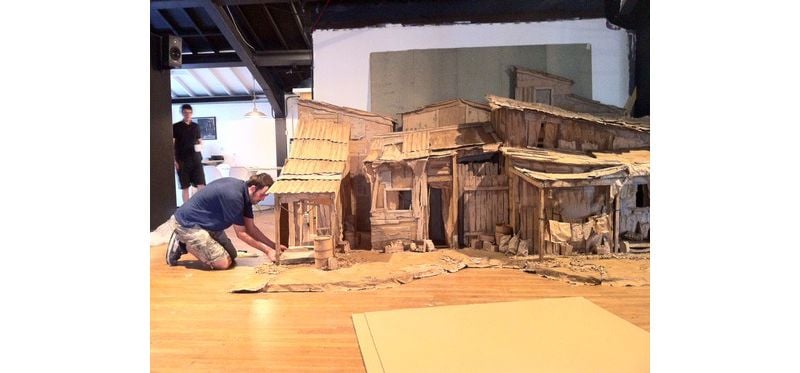These Intricate Cardboard Models Perfectly Capture the Look and Feel of World Cities
A photographer and model-maker created these dreamscapes, including a forest animal, to convey the essence of the urban metropolis
Architect Shigeru Bahn, best known for his innovative and surprisingly resilient cardboard structures, recently won the Pritzker Prize, his profession's highest and increasingly controversial award. Bahn's low-cost paper buildings demonstrate the possibilities of an ostensibly mundane material usually reserved for cheap boxes, toilet paper rolls and breakdancing surfaces.
Last year, two artists pushed the limits of cardboard beyond buildings to create cardboard cities. The catch? They're built at half scale. Inspired by the cardboard forts he built with his children, photographer Andy Rudak came up with the concept for the project and commissioned professional model-maker/set-builder/prop-maker Luke aan de Wiel to design and build cardboard street scenes. From the brick-paved streets and historic buildings of Paris to the haphazard slums of Mumbai, these beautifully detailed models use common cardboard as a proxy for stone, brick, plaster, metal, wood, and plastic, illustrating a mastery of the material that would make any architect or model-maker jealous.

The lighting and composition of the photos, not to mention the surreal presence of a single animal, gives the impression that these aren't isolated set pieces, but snapshots taken in some familiar but yet completely alien places. Dreams. "I knew I wanted the shots to portray a scene of serenity and create an almost dreamlike scenario. No movement, merely a feeling of calm stillness....without the people there the city falls silent, its just you, the buildings and the animal," says Rudak. "The fact that the animal didn’t really belong in the habitat was to aid the feeling of being in a dream."
The designs aren't based on photographs or any specific place, but are imagined scenes created after rigorous research to determine the unique architectural elements of each city that would, as aan de Wile says, "elicit an immediate recognition of the place." Rudak is more straightforward in his analysis: "The scenes are based on cliché, rather than fact."
The project raises an interesting question, one that set designers face on a daily basis. How do you distill a city? What makes Paris Paris? Are cities recognized only by clichés of built form or by something more? By some larger, ineffable idea of place imbued by history? Whatever the metric, it's obvious which city each model represents - even without the captions. And somtimes the fiction bears an uncanny resemblance to reality. "On a later visit to Japan," says aan de Wile, "I stumbled upon a street in downtown Tokyo that had two buildings next to each other that were virtually the same as the ones I had come up with a year earlier. [It was] a very spooky experience."
Each set took about three weeks to make. Other than a simple wood armature, everything is cardboard. Crisp new sheets of the material were painstakingly aged to give the street scenes a "lived in" feel. It's almost like how architects and builders specializing in historic preservation and restoration will use acid to artificially age their additions or interventions, making them appear a part of the original structure. The aging was key to making these models look real, but the surreal photographs play a huge role in that too. It feels like the cities extend beyond the edges of the photos.
For Rudak, the important thing was "how the buildings react to the light around them. Even the most humble wooden hut," he says, "can look incredible when the light hits it just right." That holds true for cardboard townhouses as well.
/https://tf-cmsv2-smithsonianmag-media.s3.amazonaws.com/accounts/headshot/Jimmy-Stamp-240.jpg)
/https://tf-cmsv2-smithsonianmag-media.s3.amazonaws.com/filer/e7/fe/e7fe583a-9165-474b-8866-4348702ebc4c/cardboard-paris.jpg)
/https://tf-cmsv2-smithsonianmag-media.s3.amazonaws.com/filer/7b/a1/7ba17e5c-748d-4193-a65b-d25941335f85/cardboard-new-york.jpg)
/https://tf-cmsv2-smithsonianmag-media.s3.amazonaws.com/filer/cf/6c/cf6c30b4-18e7-4f7b-a0eb-365cea9dd46a/cardboard-mumbai.jpg)
/https://tf-cmsv2-smithsonianmag-media.s3.amazonaws.com/filer/1c/fd/1cfda8ec-7547-4dfe-a1e9-2a21edf39461/cardboard-tokyo.jpg)
/https://tf-cmsv2-smithsonianmag-media.s3.amazonaws.com/filer/0d/62/0d62f3fe-de26-4ea3-96b2-e830471a0768/cardboard-tower.jpg)
/https://tf-cmsv2-smithsonianmag-media.s3.amazonaws.com/accounts/headshot/Jimmy-Stamp-240.jpg)